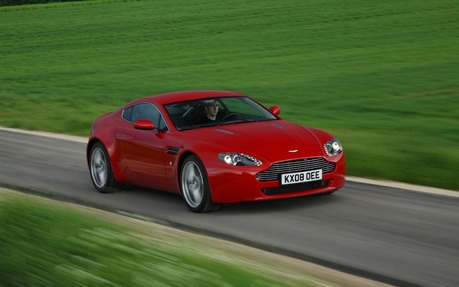2014 Aston Martin Vantage V8
Pity the Aston Martin Vantage V8. It is neither as pretty as its four-door sibling, the Rapide S, or as rapid as the top-of-the-range, 565 horsepower Vanquish. It has neither the Vanquish's melodious V12 nor the Rapide's three-step adaptive suspension. In short, it is merely the entry to the rich world of soft leather and ripping exhaust notes that is the storied English brand. And yet...it is as sexy as a strutting Victoria's Secret lingerie model (item AU-299-105 on page 23 of the spring collection offers an apt reference) and more than sporty enough to satisfy the most basic of carnal, er I should say, vehicular urges.
There may be four less cylinders than in the DB9 or the Rapide S, but 420 ponies (ironically, the same output generated by the first iteration of Aston’s V12 when it debuted in the 2001 DB9) is hardly to be sneezed at. Indeed, those 420 ponies scamper the Vantage to the same 4.7 second zero to 100 kilometres an hour acceleration time as the 550-hp Rapide S, thanks mainly to its lesser 1630 kilogram curb weight (some 360 kilos less than the four-door). It's also helped by the choice of a six-speed manual transmission or a new seven-speed manumatic, neither available in either the Rapide or the DB9.
- Also: Aston Martin Vantage GT4: Wine and Spirited Performances
- Also: Samir Sadikhov's Aston Martin DBC Concept
Nor is the exhaust note truly terrible. Indeed, as far as V8s go, it sounds quite authoritative, the 4.7-litre bridging the gap between American muscle and European sophistication. Driven in isolation, the V8 sounds glorious, though after sampling the company's V12 uncorked in sport mode, it is indeed diminished.
Helping resolve that issue is S version of the Vantage that eeks out an extra 10 ponies (for a total of 430-hp). That may not sound like much but to show how close to the edge Aston Martin is willing to tune its engines, director of global product development, Ian Minards, notes that, to eke the S’s 10 extra horses, the 4.7-litre V8 has had its ignition timing advanced to within a smidgen of piston-destroying detonation. Not only that, Aston imbues the S with a freer-flowing (that should be read louder) exhaust system and then spins the V8 to a semi-stratospheric 7,300 rpm, the very limit for piston reliability (when the rev limiter cuts in, hard) and proper lower-end oil flow.
Aston’s V8 definitely likes to be spun fast. The Vantage S’s 361 pound-feet of torque only arrives at 5,000 rpm and, although Aston claims that 76 percent of that figure is available as low as 1,500 rpm, maximum motivation still requires high revs (unlike Aston’s 6.0L V12 which is a veritable torque monster) and frequent rowing of the aforementioned seven-speed sequential automated manual gearbox. Flip the paddles fast enough, however, and the Vantage S will scoot to 100 kilometres an hour in about 4.5 seconds (only 0.3 seconds behind the V12 Vantage). That may not sound exactly Porsche-crushing, but remember the Vantage benefits from neither the tractive abilities of all-wheel-drive nor the 911 Turbo’s computer-controlled “Launch” mode. Make no mistake about it; the Vantage S feels fast.
Both Vantage and Vantage S will also untwist curves with alacrity. Unlike the more expensive DB models which sport adaptive suspensions, the Vantage has non-adjustable shock absorbers. But, said suspension is calibrated firmly indeed and suffers minimal body roll, even when hustling around a racetrack. The ultra-sticky Bridgestone Potenza RE050 – to 245/40 front and 285/35 rear — offer incredible traction and, along with the quicker-steering power-steering box (15.0:1 ratio rather than the previous 17.0:1), the revised chassis does allow controlled drifting of both front and rear tires, at least when the traction nannie is switched off.
The Vantage’s more significant fault is the aforementioned seven-speed electronically-controlled manual transmission. Unlike most such automated manuals which feature twin clutches, the Graziano (of Turin, Italy who also build the new McLaren MP4-12C’s transmission) built gearbox uses but a single clutch. On the racetrack its shifts are sufficiently speedy, at least when it’s in “sport” mode. But, on the road, like other such single clutch manumatics (such as the pre-2014 Audi R8), there’s a noticeable hesitation when shifting. It’s better than the six-speed it replaces, but in “automatic” mode, the Sportshift II is balky. In normal driving, I almost always used the paddle-shifters, the automatic setup simply being too distracting. According to Minards, Aston chose this particular transaxle (mounted in the rear where the axle resides) because the dual-clutch version was too heavy — 50 kilograms more says Minards — and too large to fit into the Vantage’s chassis.
But it is the Vantage V8's only foot wrong. As the lesser Aston, it is not so much beaten by its rivals as overshadowed by its siblings. A Cayman R will pretty much satisfy anyone's Porsche urges as well as a 911, but the gap between a Vantage V8 and a V12 Vanquish is far more noticeable. Of course, the former costs $124,289 (the S model starts at $139,038) while the latter rings in at almost 300 large, a difference sufficient, I suspect, to salve many a bruised ego.
| Test drive report | |
| Test model | 2014 Aston Martin Vantage |
|---|---|
| Trim level | V8 Coupe |
| Price range | $128,860 – $250,000 |
| Price as tested | CA$128,860 |
| Warranty (basic) | N/A |
| Warranty (powertrain) | N/A |
| Fuel economy (city/highway/observed) | 16.3 / 10.4 / N/A L/100km |
| Options | N/A |
| Competitive models | Audi R8, BMW 6 Series, Chevrolet Corvette, Ferrari California, Jaguar XK, Lamborghini Gallardo, Nissan GT-R, Porsche 911 |
| Strong points |
|
| Weak points |
|
